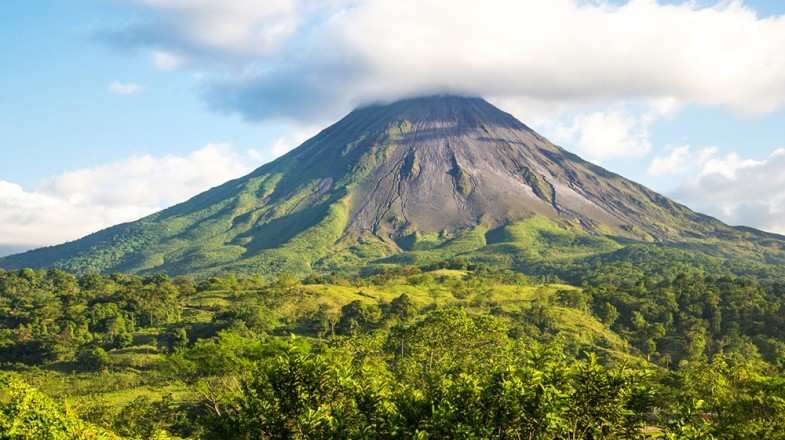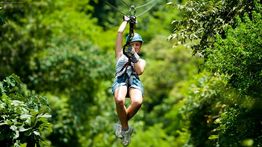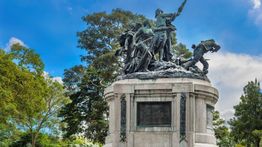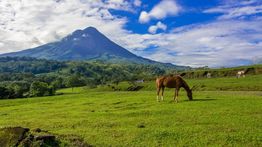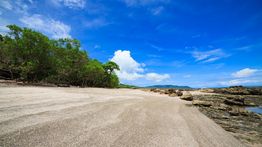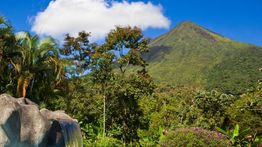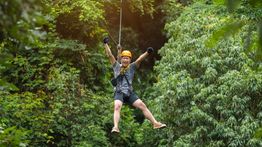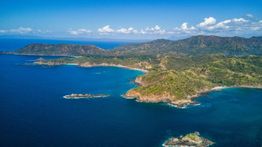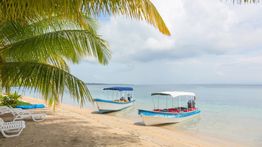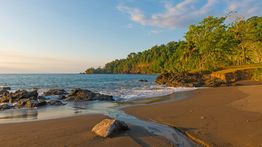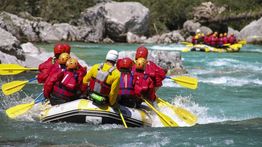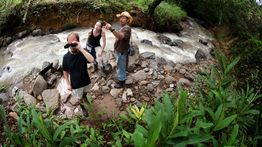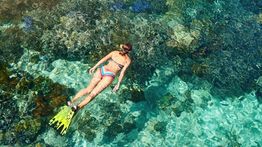Top 13 Things to Do in Costa Rica
Featuring lush rainforests, active volcanoes, hot springs, and endless stretches of pristine beaches along the Pacific and Caribbean coasts, a trip to Costa Rica offers an unparalleled experience. Traverse misty cloud forests in reserves like Monteverde, where vibrant wildlife, including sloths and tropical birds, await discovery. Delight in the flavors of locally-grown coffee and chocolate during plantation tours, or delve into the depths of adventure by exploring caves in Playa Cantanas. Be sure to sightsee iconic landmarks such as the Fortuna Waterfall. With its diverse natural landscapes and an array of activities, this compact Central American nation has rightfully claimed its place as the eco-tourism hub for tourists visiting Central America.
Don’t want to miss out on the best that Costa Rica has to offer? Explore our carefully curated list of top things to do in Costa Rica, encompassing must-visit attractions and must-do activities. Moreover, we've included alternate destinations for each activity to ensure you don't miss out on any excitement.
- Sanjay Sola
- From USA
1. Spot Colorful Macaws in Carara National Park

If there is one thing Costa Rica is best known for, it's the magnificent macaw population in the country’s lush forests. About a 90-minute drive from San Jose, boasting 4,700 hectares of rainforest, Carara National Park protects one of the largest remaining populations of scarlet macaws (ara macao) in Costa Rica. The park allows visitors to marvel at these striking red, blue, and yellow birds in their natural habitat, flitting from tree to tree, their raucous squawks echoing for miles. The park's hiking trails also provide chances to see other wildlife like monkeys, coatis, and countless tropical bird species.
Alternate destinations:
- La Selva Biological Station: A premier birdwatching destination, La Selva shelters over 420 bird species, including the majestic great green macaw (ara ambiguous). This private biological reserve provides the best opportunities to spot these endangered macaw species in the wild as they soar above the old-growth rainforest canopy.
- Corcovado National Park: Known as one of the world’s most biodiverse regions, Corcovado harbors a significant population of scarlet macaws. The macaws can often be seen and heard calling raucously as they forage in the park's lowland tropical rainforests. Corcovado's remote location on the Osa Peninsula provides precious protection for these endangered macaws to thrive in one of Central America's wildest areas.
Insider’s tip: For the best chance to spot scarlet macaws in their usual groups of half a dozen or more, plan your visit to Carara National Park during the early morning hours when they are most active.
2. Zipline in Monteverde Cloud Forest Reserve
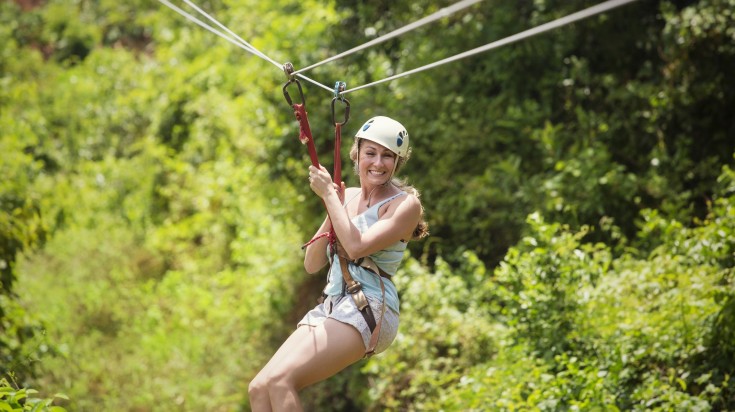
Ziplining, locally called a canopy, is one of the most popular adventure activities in Costa Rica. Experience the thrill of soaring like a bird through one of the world's most breathtaking ecosystems—the Monteverde Cloud Forest Reserve. This 25,000-acre private reserve in the Tilaran Mountains allows you to explore the treetops via a network of suspended bridges and heart-pumping zip lines, getting up-close views of the incredible biodiversity. Over 100 mammal species, 400 bird species, and thousands of plant varieties thrive in this misty, humid forest.
Alternate destinations:
- Arenal Reserve: In the shadow of the iconic Arenal Volcano, the Arenal Reserve offers a thrilling canopy tour experience. Glide through the lush rainforest canopy on ziplines and suspended bridges, getting up-close views of the area's incredible biodiversity.
- Jaco Rainforest: For an adrenaline-pumping adventure near the Pacific coast, take a canopy tour through the Jaco Rainforest. As you soar from platform to platform on ziplines high above the forest floor, keep your eyes peeled for toucans, scarlet macaws, and white-faced monkeys moving through the dense foliage. The tour culminates with an exhilarating rails ride through the treetops before returning you safely to solid ground.
Insider’s tip: For a comfortable zipline experience, wear thick, durable fabrics to prevent irritation from the harness straps against your skin. Avoid wearing shorts for the same reason!
3. Sightsee the magnificent Plaza de la Cultura in San Jose.

The beautiful capital city of San Jose is one of the best places to visit in Costa Rica and the first stop on any San Jose tour should be the magnificent Plaza de la Cultura! Set in the heart of the bustling downtown area, Plaza de la Cultura is lined with historic buildings, museums, theaters, and art galleries and is the vibrant cultural heart of the city. Admire architectural marvels like the iconic National Theater, the Metropolitan Cathedral, the Central Post Office Building, and the Supreme Court of Justice. Enjoy free outdoor concerts, street performances, and cultural festivities that often take place in the square.
Alternate destinations:
- Mercado Central: Dive into the vibrant hustle and bustle of Costa Rica's largest indoor market, Mercado Central. Wander through the maze of stalls selling fresh produce, local handicrafts, clothing, and souvenirs. Sample traditional Costa Rican dishes at the market's food court and savor delicious specialties such as casado, gallo pinto, and ceviche.
- La Sabana Park: Escape the hustle and bustle of the city and unwind in the sprawling green oasis of La Sabana Metropolitan Park. Enjoy recreational activities such as jogging, cycling, or picnicking amid lush gardens, tranquil lakes, and scenic walking trails. The park also features sports facilities, playgrounds, and cultural events, making it one of the top things to do in San Jose when you need a break.
Insider’s tip: Joining a free walking tour is an excellent way to get acquainted with San Jose's history, architecture, and culture while connecting with knowledgeable local guides.
4. Spot Sea Turtles on the Shores of Tortuguero

Journey to the remote Tortuguero National Park, a protected nesting site for several endangered sea turtle species, including green, leatherback, hawksbill, and loggerhead turtles. This coastal wilderness can only be accessed by boat or plane, adding to its isolation and untouched beauty. Time your visit during the nesting season to watch in wonder as the ancient mariners come ashore to lay their eggs in the black volcanic sand.
Alternate destinations:
- Ostional Wildlife Refuge: This refuge is renowned for the remarkable Ostional Arribada, a mass nesting event where thousands of Olive Ridley sea turtles emerge from the Pacific Ocean to lay their eggs on the same stretch of beach. It's a remarkable natural phenomenon to witness.
- Playa Grandea: Located within Las Baulas National Marine Park, Playa Grande is one of the most important nesting sites for the endangered leatherback sea turtle. Visitors can join guided night tours during the nesting season to observe these gentle giants digging their nests and laying eggs.
Insider’s tip: The best time to visit Costa Rica for turtles is between July and October in Tortuguero for green sea turtles, December to February for leatherback nesting season, April and November for hawksbill nesting season, and May to mid-August for loggerhead nesting season.
5. Go White Water Rafting on the Pacuare River

Get your adrenaline fix rafting down the Pacuare River, which has been repeatedly ranked as one of the top whitewater rafting rivers in the world. Cutting through a gorge flanked by pristine rainforest, a multi-day rafting trip allows you to paddle thrilling class III-IV rapids daily while camping on the riverbanks at night under a starry sky. Expect an incredible mix of nature, adventure, and relaxation.
Alternate destinations:
- Reventazón River: Known for its continuous stretches of challenging rapids, the Reventazón River offers an exhilarating whitewater rafting experience. The river's class III-IV rapids and its scenic tropical surroundings make it a popular destination for adrenaline seekers.
- Sarapiquí River: Winding through lush rainforests and picturesque canyons, the Sarapiquí River is a whitewater rafting haven. With rapids ranging from class II to IV, it caters to beginner and experienced rafters seeking an unforgettable adventure amidst Costa Rica's natural beauty.
Insider’s tip: You can find plenty of tour stands in the popular white water rafting locations in Costa Rica that promise you the cheapest deal. However, we advise going through a local travel expert or researching beforehand! Also, keep in mind that tipping your rafting guide 10–15% is common practice.
6. Take a Mud Bath in Miravalles Volcano

If you’re looking for a unique and rejuvenating experience, taking a mud bath in the Miravalles Volcano is one of the top things to do in Costa Rica! Located in Guanacaste, Miravalles Volcano is part of the Miravalles Protected Area and is renowned for its geothermal springs and mud pots. Close to the volcano's base, the mud baths are fed by hot springs that fill the natural pools filled with warm, mineral-rich mud. The mud is believed to have healing properties for the skin and is known to exfoliate and detoxify.
Alternate destinations:
- Rincon de la Vieja Volcano National Park: Named for the Rincon de la Vieja Volcano, this park in the northwestern province of Guanacaste is another excellent spot for enjoying a mud bath. Natural hot springs and mud baths are scattered around the park, offering fantastic opportunities for hiking, wildlife spotting, and exploring other volcanic attractions.
- Tabacon Thermal Resort & Spa, Arenal Volcano: Nestled at the base of the iconic Arenal Volcano in the northern lowlands of Costa Rica, Tabacon Thermal Resort & Spa is renowned for its luxurious thermal springs and spa facilities. You can soak in your mud bath surrounded by a lush tropical landscape and enjoy invigorating spa treatments in this unique volcanic mud area.
Insider’s tip: When taking your mud bath, wear old swimwear or clothing you don't mind getting dirty, as the mud may stain fabrics.
7. Look for Sloths in Manuel Antonio National Park
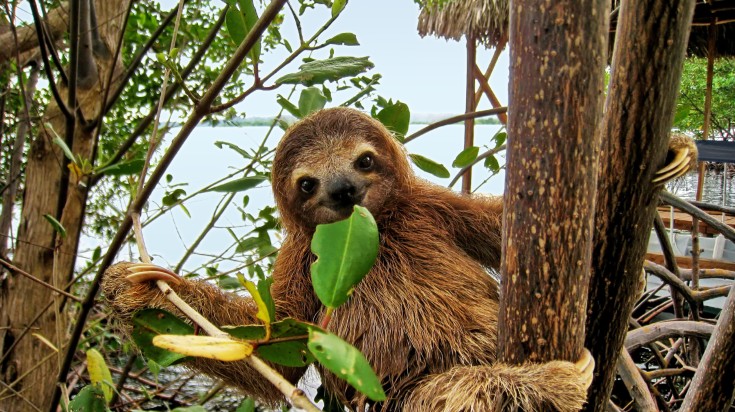
Manuel Antonio National Park on the Pacific coast provides a natural sanctuary for the world's slowest mammal, the adorable sloth. It houses both two-toed and three-toed sloths native to Costa Rica. Exploring the park's lush hiking trails offers the chance to spot these lazy tree-dwellers munching leaves high up in the canopy. Beautiful white-sand beaches framed by lush forests provide perfect picture-worthy backdrops.
Alternate destinations:
- Corcovado National Park: This must-visit national park on the Osa Peninsula also houses a healthy population of sloths. The park's rugged terrain and dense rainforests provide an ideal habitat for these natural creatures.
- La Fortuna: Located near the Arenal Volcano, the lush rainforests surrounding La Fortuna are home to a few Costa Rican sloths. If you are lucky, you can spot these animals in their prime spotting locations.
Insider’s tip: To increase your chances of spotting a sloth in the massive Corcovado National Park, we recommend taking a multi-day tour. An expert guide can take you to the exact spotting areas of these slow-paced animals.
8. Hike to La Leona Waterfall in Curubandé de Liberia

For a true off-the-beaten-path adventure, go to the remote Curubandé region near Liberia in the northwestern UNESCO-listed Guanacaste Conservation Area. Here, you can take a moderate 2.5-mile roundtrip hike through the dry tropical forest to the stunning 90-meter-high La Leona Waterfall. Dip in the waterfall’s natural crystal-clear pool to cool off after your trek.
Alternate destinations:
- San Gerardo de Dota: Embark on the challenging yet rewarding hike to the Los Quetzales National Park, a lush cloud forest reserve home to the resplendent quetzal, one of the most beautiful birds in the world. The round-trip trek is approximately 7 miles and offers breathtaking vistas of the Talamanca Mountain Range.
- Tenorio Volcano National Park: Explore the stunning Tenorio Volcano National Park, home to the famous Rio Celeste, a river that takes on a mesmerizing blue hue due to the mixture of sulfur and calcium carbonate. Hike along the well-marked 6-kilometer-long trail, crossing suspension bridges and passing by the vibrant Tenorio Volcano until you reach the breathtaking Rio Celeste Waterfall. Take a dip in the striking blue waters or simply admire the natural beauty surrounding you.
Insider’s tip: Access to Tenorio Volcano National Park, is limited to 1000 visitors per day and only 500 people are allowed on the trail at one time. You might want to start out early to make sure you get in!
9. Indulge in Costa Rican Cusine in Puntarenas

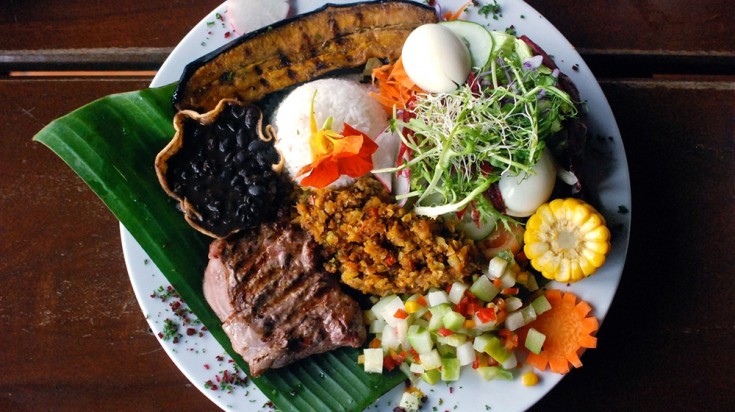
One of the best places to visit in Costa Rica for authentic, delectable cuisine is the historic port city of Puntarenas on the Pacific coast known for its Vietnamese street food stalls that line the streets of downtown. Indulge in beloved dishes like casado (rice with meat/fish and sides), patacones (fried plantains), and fresh ceviches. The province is best known for the quintessential street food, vigorones, hand-fried chicharrones combined with a fresh cabbage salad, and boiled green plantains, all wrapped up in a banana leaf.
Alternate destinations:
- San Jose: The bustling capital city of San Jose offers a tantalizing array of authentic Costa Rican flavors. Wander through the lively markets of the city center, where you'll find an abundance of sodas (casual family-owned Costa Rican restaurants serving traditional food) serving up hearty casados, and mouth-watering tamales. Don't miss the opportunity to sample Costa Rica's national dish, galla pinto, a hearty dish featuring rice and beans as its base.
- Limon: The Caribbean province of Limón is a culinary gem, offering a unique fusion of Costa Rican and Afro-Caribbean flavors. Explore the vibrant city of Puerto Limón, where you'll find roadside stands selling succulent rondon, a hearty seafood stew brimming with fish, shellfish, and aromatic spices. Satisfy your sweet tooth with the decadent sweet bread, pan de coco, or indulge in the creamy, coconut-infused rice pudding called tembleque. Pair your meal with a refreshing glass of fresco de guanábana, a tangy soursop juice that's a local favorite.
Insider’s tip: Bear in mind that eateries in Costa Rica add a 10% gratuity to your bill.
10. Catch the Waves in Tamarindo
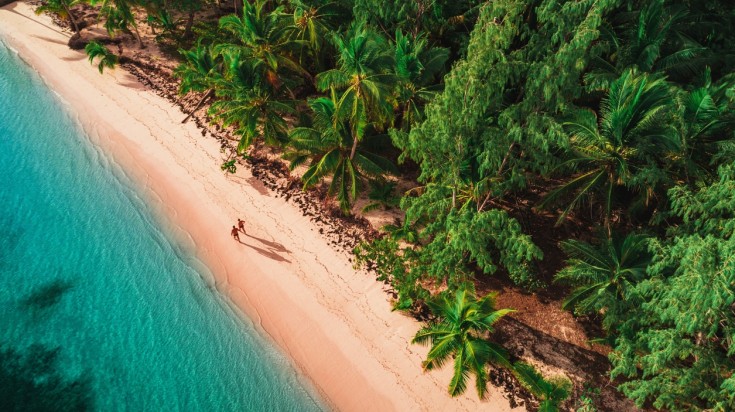
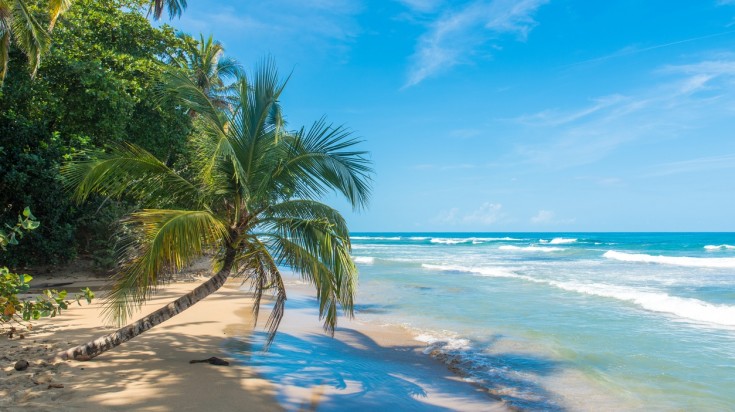
Surf’s up! Costa Rica has some of the best places to surf in the world, and Tamarindo is one of them! Located on the Pacific coast of the Guanacaste province, Tamarindo is renowned for its consistent waves, warm waters, and vibrant surf culture, making it one of the best places to surf in the country. You’ll find a consistent year-round swell, warm water, and a range of surf breaks suitable for all skill levels. Tamarindo's vibrant surf culture adds to the allure, and the town is peppered with surf shops, beachfront bars, and restaurants where surfers gather to swap stories, share tips, and unwind after a day on the water.
Alternate destinations:
- Pavones: Pavones is famous for its legendary left-hand point break, which is one of the longest in the world. You can ride almost two kilometers on the right swell and in good tide conditions! Situated on the southern Pacific coast near the border with Panama, Pavones has a remote and off-the-beaten-path vibe with challenging surf breaks for adventurous surfers.
- Santa Teresa: Located on the southern tip of the Nicoya Peninsula on the Pacific coast, Santa Teresa is another top-notch spot for surfing in Costa Rica. It has beautiful beaches and various surf breaks suitable for surfers of all skill levels, like Playa Carmen and Playa Hermosa. You can also enjoy year-round surfing here with consistent swell.
Insider’s tip: Tamarindo is one of the best vacation spots in Costa Rica and can get crowded, especially during peak surf season. Explore nearby breaks such as Playa Langosta, Playa Grande, and Playa Avellanas for different surfing experiences and fewer crowds.
11. Soak in Volcanic Hot Springs in La Fortuna
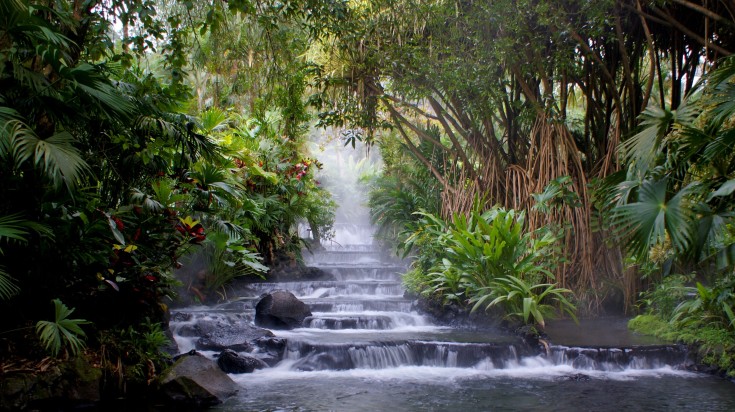
Unwind amidst the natural beauty of the Arenal region with a soak in a volcanic hot spring in La Fortuna. Dotted about the base of the Arenal Volcano, these hot springs create a tranquil oasis where you can soak in mineral-rich thermal waters surrounded by lush rainforest and rugged volcanic landscapes. The warm water helps improve circulation, soothe sore muscles, and promote relaxation, making it the perfect remedy after hiking, adventure activities, or sightseeing.
Alternate destinations:
- Rio Perdido Thermal River: Nestled in the wilderness of Costa Rica's Guanacaste province near Bagaces, Rio Perdido is renowned for its natural hot springs, scenic beauty, and eco-friendly ethos. Naturally heated by the Miravalles Volcano, dozens of natural thermal pools at varying temperatures offer a secluded and serene hot springs experience.
- Rio Negro Hot Springs: Naturally heated by Rincon de la Vieja Volcano, the largest volcano in the Guanacaste region, the Rio Negro Hot Springs is a great spot to relax in the Rincon de la Vieja National Park. There are 10 natural spring pools with hanging bridges and fewer crowds than other spots.
Insider’s tip: If you plan to visit one of the more popular hot springs resorts in La Fortuna, making reservations in advance is a good idea, especially during peak tourist season.
12. Visit Coffee and Chocolate Plantations in Bribri Indigenous Reserve

Costa Rica is famous for producing high-quality coffee and chocolate, and one of the best places to delve into the rich history of these two agricultural gems is the Bribri Indigenous Reserve. Situated in the lush rainforests of the Talamanca Mountains in southeastern Costa Rica, the Bribri Indigenous Reserve is home to indigenous communities that have preserved traditional farming practices for generations. Enjoy guided tours of the plantations, meet local communities, and learn about coffee and cacao cultivation.
Alternate destinations:
- Monteverde: Nestled in the misty cloud forests of the Cordillera de Tilarán in northwestern Costa Rica, Monteverde is renowned for its rich biodiversity and vast coffee and chocolate plantations. Guided coffee and chocolate tours provide the chance to learn about the production processes behind these beloved treats, hands-on experiences, and delicious tastings.
- Turrialba: Home to lush landscapes, winding rivers, and thriving coffee plantations, Turrialba is another fertile region that produces some of Costa Rica’s best coffee and chocolate. Nestled in the rich agricultural area of the Central Valley, the town is close to the Turrialba Volcano and the scenic Pacuare River, making it a fantastic spot for nature lovers, adventure seekers, chocaholics, and java junkies.
Insider’s tip: When visiting the Bribri Indigenous Reserve, be mindful of cultural sensitivities and ask for permission before taking photos of people or sacred sites.
13. Kayak the Sea Caves in Playa Ventanas
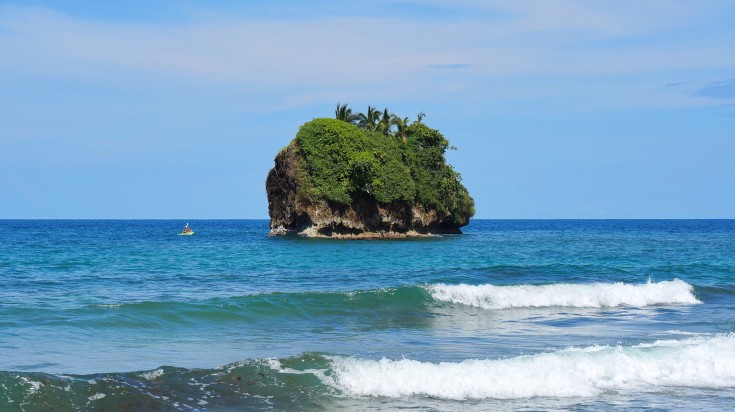
One of the most enthralling things to do in Costa Rica is to kayak through the incredible Caves of Playa Ventanas near the town of Ojochal on the southern Pacific coast. These stunning sea caves, formed by thousands of years of erosion, feature cathedral-like domed ceilings and natural skylights that let in rays of sunlight. Paddle into these mysterious chambers for an unforgettable experience.
Alternate destinations:
- Playa Danta, Las Catalinas: Situated on the stunning Guanacaste coast, Playa Danta offers excellent opportunities for sea kayaking. Paddle along the tranquil turquoise waters and explore the beautiful rocky coves and sea caves that dot this picturesque beach. The calm, protected waters make it an ideal spot for kayakers of all skill levels.
- Isla Tortuga: This small island off the coast of Puntarenas is a great destination for sea kayaking adventures. Explore the island's stunning beaches, mangrove forests, and crystal-clear waters teeming with marine life. Kayaking tours often include snorkeling stops, allowing you to witness the vibrant underwater world up close.
Insider’s tip: Kayak through the Playa Ventanas caves during low tide, as some entrances can be inaccessible or difficult to navigate during high tide.
